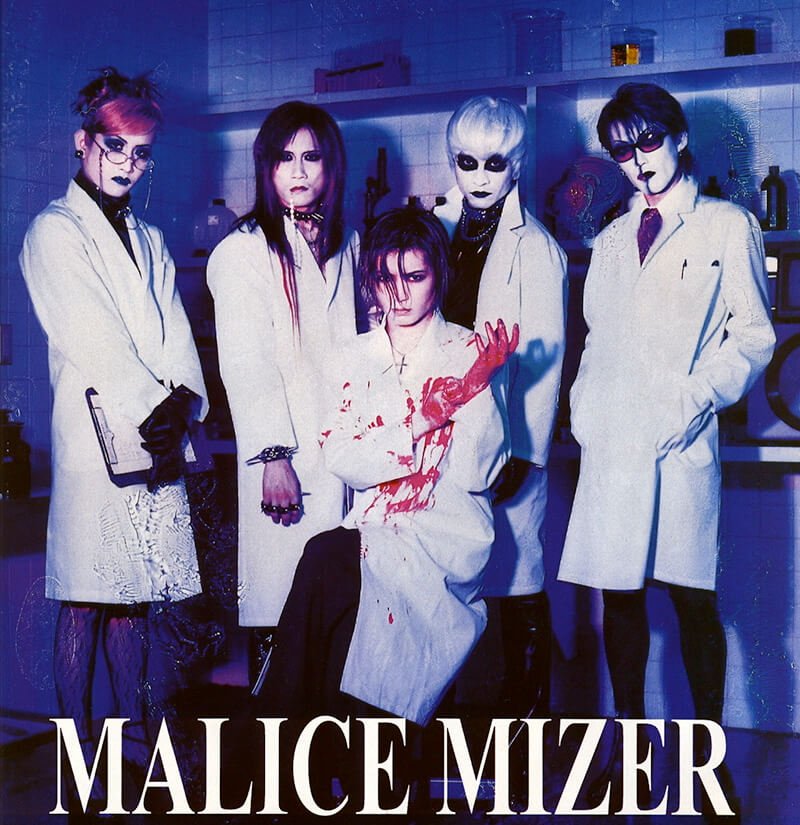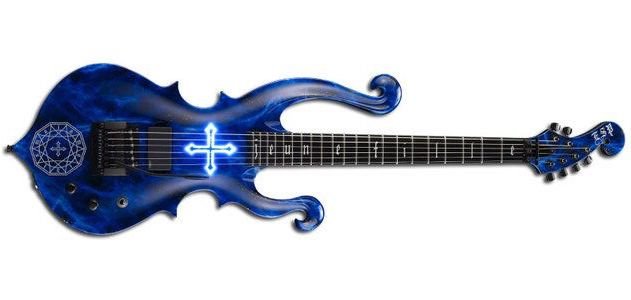Mana is one of the names that every Jrock fan must have encountered in the past.
Yesterday we kickstarted our Mana and Moitié week by going through a recap of the history of one of the most well-known Gothic Lolita brands in existence, Moi-même-Moitié. We have already talked in depth about the brand itself, how it has come to be and what it stands for. Today, we shall have a closer look at the other aspects of Mana’s life and career; a deeper insight into the person behind the brand.
Mana is a household name on both the music scene and the Lolita fashion scene. Let’s look at how one of the pillars of the visual kei and Harajuku subcultures got to where he is now.
The mystery of the name
Mana’s stage name could be loosely translated as “devil’s name” or “evil name”, as it is written with the kanji “魔” commonly used in words like devil (悪魔/akuma), witch (魔女/majo) or magic (魔法/mahou) and “名” (name). It is, however, often written in simple katakana. Just as Mana’s age, his real name has not been revealed to the public as of yet, and there seems to be no intention of doing so anytime soon. Members of Mana’s fanbase often refer to him using the Japanese honorific -sama, as Mana-sama, a habit that has been around among the fans since the days of Malice Mizer.
Early life and influences
Mana was born in Hiroshima, Japan on March 19 of an indeterminate year. His parents taught music, and so he has had a close connection to it since early childhood. He began learning to play piano as a child, and still likes classical music a lot, on top of being a devout metal fan. After all, classical influences are very apparent throughout all of Mana’s musical compositions, be it for Malice Mizer, Moi dix Mois, or others, like the work he has done for Kanon Wakeshima’s first album.
Mana has been into metal since his teens. In fact, he says that the first concert he has ever seen was a Mötley Crüe one, and the first album he’s ever purchased was Iron Maiden’s Piece of Mind (released in 1983). He has remained a fan of metal to this day, admitting to liking SLAYER amongst other bands.
Ever since he has discovered metal and other hard music, he has been influenced by it—be it in fashion or interests. Besides guitar, he began learning to play drums as a teen as he admired Mötley Crue’s drummer Tommy Lee.
He still plays drums to this day, usually performing as a drummer annually each December at the Moi dix Mois’ Dis Inferno live. It was Dis Inferno in 2007 that saw Mana’s brief reunion with the members of the cover band he’d played with in high school. Under the name Mana’s not Dead, these businessmen clad in metal costumes played a cover of a song from the band THE STAR CLUB.
After finishing high school, Mana enrolled in a music school in Osaka. Once he’d moved to Osaka he joined a punk band called Girl’e where he performed under the stage name Serina. When imagining young Mana of high school age, we cannot picture anything akin to Mana of today. Young Mana was a punk through and through, in fact, he claims that in his youth he really hated all girly things—only after joining Girl’e did his looks start to shift towards the more androgynous aesthetic that we all know and love. Girl’e produced two demo tapes, for one of which Mana drew the cover art.
Soon, however, at the start of the 1990s, Mana left all of Osaka behind. Dissatisfied with the direction his music studies were going and with the rigid outlook that the school had on music, which wasn’t quite compatible with his nonconformist attitude, he dropped out and decided to move to Tokyo to pursue a musical career.
Meeting Közi and forming MALICE MIZER
Taking up work at a karaoke bar, he soon became friends with Közi, and with him, joined the band Matenrou, where he played bass, while Közi became the guitarist. Matenrou disbanded in 1992, and the suddenly bandless Mana and Közi decided to start a band of their own. Wanting to create a new style, they founded the band that would become wide-known across all visual kei subcultures for decades to come—Malice Mizer. They played gothic rock with strong influences of classical music that Mana had found a renewed love for. They were also the first visual kei band to put heavy emphasis on theatrical elements in their performances.
Malice Mizer shot up into popularity in the following years, practically infiltrating the mainstream even in spite of looking so outlandishly visual kei in their color-coordinated aristocratic costumes. They remained at the height of popularity producing hit after hit from 1995 until about 1999 when the band was struck by tragedy. As the singer Gackt absconded from the band to pursue a solo career, Malice Mizer’s beloved drummer Kami tragically passed away.
Malice Mizer, however, continued on. Mana gathered his remaining members and the band tried to move on. They left the major label Columbia to return to Mana’s indie label Midi:Nette, after a while took a new vocalist Klaha on board, and continued from there on with fewer members and with a much darker tone to both their music and visuals.
The final run was unfortunately short-lived, and the members decided to part ways in December 2001, as the band went on indefinite hiatus. Indeed; did you know that Malice Mizer never actually broke up?
Following 2010, Mana, Közi and Yu~ki have begun to meet again to perform as Malice Mizer at the Deep Sanctuary lives.
The beginning of Moi dix Mois
After Malice Mizer went their separate ways, some of the members gradually faded into complete obscurity—Yu~ki stays away from the music industry for the most part, and Klaha has left music completely. Other members have not even been able to contact Klaha for Malice Mizer’s 25th anniversary. In 2002, Mana launched a solo project, a gothic metal band named Moi dix Mois.
So far, Mana has been the sole composer of all the music for Moi dix Mois, which includes writing all the lyrics. Up until 2004, Mana was actually the only real member of Moi dix Mois, everyone else was considered support. Since then, Mana has still remained the only constant member throughout the changing line-up.

With this band, Mana truly branched out overseas—Moi dix Mois went on several overseas tours in the first five years following its debut, even playing at the famous Wave-Gotik-Treffen in Germany in 2006. The band is currently semi-active, playing the minimum of four performances each year. They have, however, not released any new music since 2012.
Besides Moi dix Mois, Mana has also worked as a producer. He’s produced the lolita singer Kanon Wakeshima and even wrote music for her, and he’s technically the person who discovered the vocalist Kaya, as he produced Kaya’s first darkwave electro band Schwarz Stein under his label Midi:Nette until their disbandment in 2004.
Relationship with fashion
Mana has been very fashion-conscious ever since his early life. At first, it was just metal and punk fashion that he used to express himself. He began to dye and style his hair in high school, customized his school uniform and other clothes to better suit his tastes, experimenting with designs. This would, later in life, culminate in him founding his own fashion brand, Moi-même-Moitié.
As he grew older and gradually outgrew his aggressively punk phase, he was entranced with the vastly different range of options that feminine style had compared to men’s fashion. Young Mana began to explore the meaning of gender in fashion and eventually came to the conclusion that he could just wear whatever he wanted. And that he did; be it on stage or off stage, Mana soon became for many the symbol of absolute self-expression and disregard of the arbitrary gendering of fashion. Many of the costumes from his Malice Mizer days such as those by Yukari Ohba, a designer famous for dressing many Jrock bands, have become iconic in the visual kei fans’ collective consciousness, and many photos of him sporting androgynous outfits off stage still circulate the internet.
Mana’s interest in fashion, of course, never left. These days, Mana claims to still be quite involved with Moi-même-Moitié design; he makes sure to check out all the initial mockups of new items and is involved in the print design. For example, the well-known Alchemy print has been designed by him.
Guitars of the gothic icon
There are many iconic things when it comes to Mana. Be it blue roses that have become a symbol of sorts for him so that fans associate them with him immediately, his famous disregard for gender roles, or some of the aspects of his aesthetic in his Moi dix Mois days—the classical silhouette of his stage attire, with the voluminous hair, huge platforms, corset and an open skirt.
Accompanying Mana’s Gothic aesthetic are his iconic guitars—the custom ESP Jeune Fille series. There are several of them, among the most well-known being a white bloodstained one, or the Lazuli model. The newest addition to the guitar lineup is the ESP Jeune fille X Ferrum -Cross Ray illusion- revealed at an exhibition event in 2017. You can find the recent models on the official ESP website, with the most expensive Ferrum model setting you back a whopping 1,000,000 yen.
Interests and hobbies
Mana is very fond of cooking; among his favorite foods is curry and eel, and in the wild, he has been observed producing quite a number of very blue consumables from blue cocktails to vividly cyan curry.
He’s also a baseball fan, his favorite team being Hiroshima Carps. He has also mentioned how much he loves horror movies, specifically the old classical ones, citing Dario Argento’s Suspiria as his most favorite movie. We can definitely see these movies’ influence the aesthetics of both Malice Mizer and Moi dix Mois. For example, compare the vivid reds and high contrasts of Suspiria to the music video for Malice Mizer’s Beast of Blood.
What you also wouldn’t guess at first glance is how immensely invested in video games and video game consoles Mana is. He has an admirable collection of old-school gaming hardware, and used to be featured in the gaming magazine Game Labo with his column titled Mana-sama’s Game Inferno, coursing through three different titles with slight changes (Mana-sama’s Nostalgic Game Inferno, Mana-sama’s Deep Game Inferno, and Mana-sama’s Chance Meeting Game Inferno, translated respectively) . The column ran from March 2012 until September 2014, and Mana’s contributions to the magazine were later compiled and released as a 98 page book titled Game Inferno Ultimate.
End
And thus our history lesson is completed. Did you learn something new? Do you have a favorite piece of Mana trivia, whether it is found within this post or not? Let us know!
Tomorrow we will bring you an exclusive interview with a member of Moi-même-Moitié’s hardworking staff. After that, stay tuned for some more exclusive content from Mana himself!













